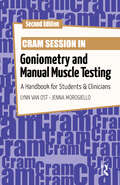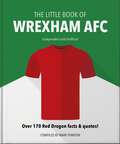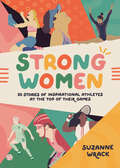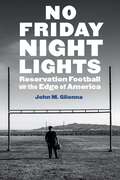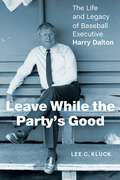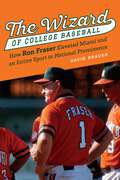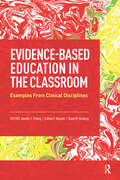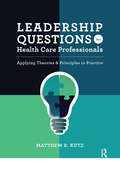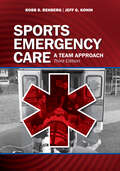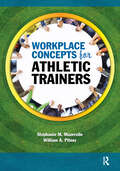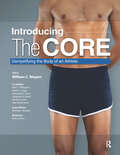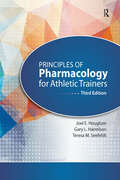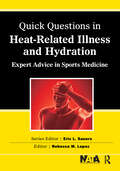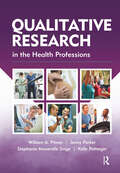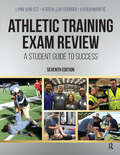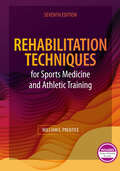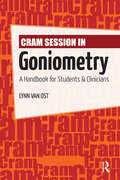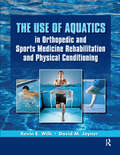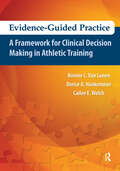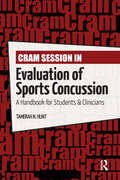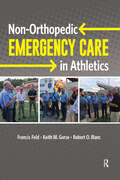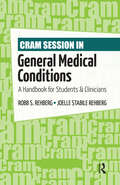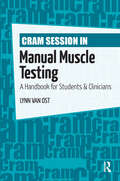- Table View
- List View
Cram Session in Goniometry and Manual Muscle Testing: A Handbook for Students and Clinicians
by Lynn Van Ost Jenna MorogielloNewly updated, Cram Session in Goniometry and Manual Muscle Testing: A Handbook for Students & Clinicians, Second Edition, is a descriptive quick reference guide for rehabilitation professionals organized in a “head-to-toe” format, including more than 400 photographs and supplemented with concise and illustrative examples of various techniques.The new edition of this text maintains the original essence of the first edition while touching upon updated information to speak to new clinicians. Minor revisions, such as adding color to the headers and to the sections, allow the reader easier access to the topics. An expanded appendix and up-to-date content touch on newer technology being used and developed in these areas of clinical evaluation.What is in your Cram Session: In the Goniometry section, subdivisions are broken down into type of joint, capsular pattern, average range of motion for each movement, patient positioning, goniometric alignment, patient substitutions, and alternative methods of measurement. In the Manual Muscle Testing section, subdivisions are broken into the specific movement to be tested, average range of motion, prime movers of the movement, secondary movers of the movement, anti-gravity patient position, gravity minimized patient position, stabilization and grades, substitutions for the movement, and points of interest for that particular muscle group. Cram Session in Goniometry and Manual Muscle Testing: A Handbook for Students & Clinicians, Second Edition, is an informative, well-organized handbook for all students, instructors, and clinicians in physical therapy, occupational therapy, athletic training, orthopedics, or any allied health professional who treats musculoskeletal disorders.
The Little Book of Wrexham AFC: Over 170 Red Dragon facts & quotes! (The\little Book Of... Ser.)
by Mark PearsonWelcome to Wrexham! Everyone in the world is talking about Wrexham AFC – the Red Dragons are on fire. In 2023, the team achieved their fairy-tale dream of promotion after 15 agonising years of languishing at the very bottom of the lowest league. They did it, in part, thanks to two Hollywood superstars, Ryan Reynolds and Rob McElhenney, who purchased the club in 2020, and promptly took the team on a superhero-inspired adventure back to the top of the turf.This provincial Welsh football club has now been catapulted onto the world's stage, thanks to the hit Disney+ documentary that followed the celebrities' acquisition, the mega-watt signings, and the dramatic twists and turns that felt straight out of a Hollywood script."I love every second of hating it. Wrexham AFC is the greatest drug on earth." Ryan ReynoldsFounded in 1864, the same year Abraham Lincoln was re-elected as president amidst America's Civil War, Wrexham is the oldest football club in Wales.
Strong Women: Inspirational athletes at the top of their game
by Suzanne WrackOverpower. Overtake. Overcome. – Serena WilliamsThroughout history, every woman pulling on spikes, lacing up boots and picking up a racquet has been a rebel – and this explosive book aims to uncover the often hidden histories behind 50 of these incredible pioneers.From the first Black woman to be a professional softball player, Betty Chapman, to the iconic 'Battle of the Sexes' match won by Billie Jean King, and from trans trailblazer Laurel Hubbard to Emma Raducanu's unforgettable US Open win, award-winning sports journalist Suzanne Wrack celebrates sporting giants at the absolute top of their games.
The Little Book of Wrexham AFC: Over 170 Red Dragon facts & quotes! (The\little Book Of... Ser.)
by Mark PearsonWelcome to Wrexham! Everyone in the world is talking about Wrexham AFC – the Red Dragons are on fire. In 2023, the team achieved their fairy-tale dream of promotion after 15 agonising years of languishing at the very bottom of the lowest league. They did it, in part, thanks to two Hollywood superstars, Ryan Reynolds and Rob McElhenney, who purchased the club in 2020, and promptly took the team on a superhero-inspired adventure back to the top of the turf.This provincial Welsh football club has now been catapulted onto the world's stage, thanks to the hit Disney+ documentary that followed the celebrities' acquisition, the mega-watt signings, and the dramatic twists and turns that felt straight out of a Hollywood script."I love every second of hating it. Wrexham AFC is the greatest drug on earth." Ryan ReynoldsFounded in 1864, the same year Abraham Lincoln was re-elected as president amidst America's Civil War, Wrexham is the oldest football club in Wales.
No Friday Night Lights: Reservation Football on the Edge of America
by John M. GlionnaNo Friday Night Lights is the story of a rural Nevada high school football team that never wins. Veteran reporter John M. Glionna examines the 2022 season in which the McDermitt Bulldogs practiced for weeks in the summer only to learn once again that they had come up short of the necessary players due to the dwindling population on the Fort McDermitt Indian Reservation on the Nevada-Oregon border. Eight-man football helps give the coaches and kids a sense of community—despite a lack of wins, and despite their home&’s status as one of the most remote locations for a public school in the West. Glionna&’s relationships with coaches, players, parents—and even those McDermitt residents remotely connected to high school football—provide telling insights into local lives, many of them from the Paiute and Shoshone tribes of Fort McDermitt. Although victory and recognition elude the players, Glionna illuminates their hard work and dedication—leaving the reader with glimpses of life on the ground in &“flyover&” country.
Leave While the Party’s Good: The Life and Legacy of Baseball Executive Harry Dalton
by Lee C. KluckHarry Dalton was a front office executive in Major League Baseball for more than forty years, serving as general manager for the Baltimore Orioles (1966–71), the California Angels (1972–77), and the Milwaukee Brewers (1978–91). He was the principal architect of the Orioles&’ dynasty and of the only American League Championship the Brewers ever won. In this definitive biography of Dalton (1928–2005), Lee C. Kluck tells the full and colorful story of a man many consider the first modern baseball executive. In 1965 the Orioles hired Dalton to be the chief team builder and to oversee baseball operations. This was a turning point in the history of baseball, creating a new kind of executive that other teams soon began to model. In Leave While the Party&’s Good Kluck details Dalton&’s pre-baseball life, showing that from an early age he developed traits that would shape the rest of his life in baseball. Dalton&’s early career in Baltimore, building up the organization&’s farm system, would inform his later days in higher management and help turn the Orioles into a dynasty. Dalton&’s move to California coincided with the arrival of free agency, forcing him to evolve his team-building approach. Following his departure from the California Angels after trading for the pieces that would make them winners in 1978, Dalton hired on with the Milwaukee Brewers&’ owner Bud Selig and made the Brewers a winning team for most of the next decade, including another pennant in 1982. Dalton won with big payrolls and small ones. He won before and after free agency. He built winning teams from nothing. Leave While the Party&’s Good details all this and gives insight into how his legacy continues to influence baseball today.
The Wizard of College Baseball: How Ron Fraser Elevated Miami and an Entire Sport to National Prominence
by David BrauerNo one changed the landscape of college baseball like Ron Fraser. The sport enjoyed little national interest until Fraser arrived at the University of Miami in 1963 and built his program into an entertainment empire and a national champion. Nationally televised college baseball games on ESPN can be traced back to Fraser&’s lobbying work in the network&’s early days. His efforts resulted in coverage growth and paved the way to making the College World Series one of ESPN&’s marquee events. He created zany, one‑of‑a‑kind promotions, such as an open-heart surgery for one &“lucky&” fan (redeemable in a five‑year window) and the first mascot devoted to a college baseball team (the Miami Maniac). Aimed at gaining attention for his program and putting fans in the seats, his innovations achieved desired results on both fronts. Miami Hurricanes baseball became widely popular as the sport&’s main draw in South Florida long before Major League Baseball expanded to the market full time. Fraser&’s biggest impact was on the field. Before the Miami Hurricanes football program became a household name, he put the school&’s athletics program on the map by winning its first national championship. Fraser inherited a floundering baseball program that had no equipment or following and could pay him only as a part-time employee; he built that program into a perennial national power that made regular appearances at the College World Series. Along the way, he developed countless players into All‑Americans, MLB Draft picks, and eventual Major Leaguers. While some coaches have matched his wins and championships, none compare to his trailblazing and impact on an entire sport. David Brauer traces the roots of modern-day college baseball&’s success to Fraser&’s work at Miami. The Wizard of College Baseball is an inspirational and entertaining reflection on how one man forever changed college baseball—accelerating the sport&’s growth and setting a new standard for modern college baseball well ahead of his time.
Evidence-Based Education in the Classroom: Examples From Clinical Disciplines
by Jennifer Friberg Colleen Visconti Sarah GinsbergEvidence-Based Education in the Classroom: Examples From Clinical Disciplines shows educators how to use evidence to inform teaching practices and improve educational outcomes for students in clinically based fields of study.Editors and speech-language pathologists Drs. Jennifer C. Friberg, Colleen F. Visconti, and Sarah M. Ginsberg collaborated with a team of more than 65 expert contributors to share examples of how they have used evidence to inform their course design and delivery. Each chapter is set up as a case study that includes: A description of the teaching/learning context focused on in the chapter A brief review of original data or extant literature being applied A description of how evidence was applied in the teaching/learning context Additional ideas for how evidence could be applied in other teaching/learning contexts across clinical disciplines Additional resources related to the pedagogy described in the case study (e.g., journal articles, books, blogs, websites) Educators in the fields of speech-language pathology, audiology, nursing, social work, sports medicine, medicine, dietetics, dental assisting, physician assisting, radiology technology, psychology, and kinesiology—already familiar with evidence-based practice—will find this resource helpful in implementing evidence-informed approaches to their teaching.While the content in clinical programs is quite different, there are many similarities in how to teach students across such programs. Evidence-Based Education in the Classroom: Examples From Clinical Disciplines highlights these similarities and represents a masterclass in how to practice evidence-based education.
Leadership Questions for Health Care Professionals: Applying Theories and Principles to Practice
by Matthew KutzLeadership Questions for Health Care Professionals: Applying Theories and Principles to Practice by Dr. Matthew R. Kutz presents some of the most common leadership questions with the intent to facilitate intrigue and dialogue about the general concept of leadership and an awareness of potential leadership issues facing health care professionals.Leadership Questions for Health Care Professionals presents responses that will initiate discussion, as well as offer solutions based on the best available evidence across a wide spectrum of relevant research. Discussion questions at the end of each response will allow the reader to engage in critical thinking and re-evaluate their experiences and offer new insights into their leadership journey.Sections include questions on key issues for health care professionals: The essence of leadership Leadership development Teamwork and communication Change Organizational culture and complexity Leadership ethics and power Diversity and multicultural leadership Leadership Questions for Health Care Professionals takes an interprofessional and interdisciplinary approach and is relevant for athletic trainers, physical therapists, occupational therapists, speech-language pathologists, nurses, physicians, and more.Leadership Questions for Health Care Professionals: Applying Theories and Principles to Practice offers students a broader conceptual understanding of leadership, as well as the depth required by seasoned health care clinicians, managers, and executives who are looking for practical and evidence-based insights to their toughest leadership issues.
Sports Emergency Care: A Team Approach
by Jeff G. Konin Robb RehbergFor more than a decade, Sports Emergency Care: A Team Approach has filled a void in athletic training education on the subject of emergency care. Now, this updated Third Edition continues to pave the way to prepare athletic training students beyond traditional first aid training as well as providing specific information on emergency situations in sports for emergency medical services (EMS) professionals. In this updated Third Edition, Dr. Robb S. Rehberg and Dr. Jeff G. Konin, along with their 13 contributors, have created a resource that can be used in athletic training education programs as a core text in a sports emergency care course; a supplemental text in several courses that address immediate care within an athletic training education curriculum; and it can be used by EMS educators in developing continuing education programs for prehospital providers. Some of the topics included in the Third Edition: Assessment of Sports Emergencies Cardiovascular Emergencies Management of Traumatic Brain Injury Fractures and Soft Tissue Injuries Managing Mental Health Emergencies Care of Athletes with Disabilities Emergencies in Sports for the Aging Athlete Regardless of discipline, it is important for all health care providers caring for ill or injured athletes to be knowledgeable and proficient in managing sports emergencies. This ability can only be achieved through preparation and practice, and Sports Emergency Care: A Team Approach, Third Edition continues to be a groundbreaking text that gives access to the essential resources health care providers need to address sports emergencies. This includes but is not limited to athletic trainers, emergency medical technicians and paramedics, and physicians.From the Foreword: “Emergencies can occur anytime and anywhere in sports, including at a practice or on the bus traveling to an event. After nearly 40 years as a professional sports athletic trainer, these emergency moments give me pause. Preparation is the key to successful outcomes in all emergencies.” —Ronnie P. Barnes, MS, ATC Senior Vice President, Medical Services Head Athletic Trainer New York Football Giants
Workplace Concepts for Athletic Trainers
by William Pitney Stephanie MazerolleAthletic trainers often find themselves immersed in organizations that can critically influence the way in which they fulfill their professional obligations. The workplace can offer many situations that are challenging, particularly for those athletic trainers who are transitioning into clinical practice.With that in mind, Workplace Concepts for Athletic Trainers provides readers with clear and meaningful information that addresses common concepts and issues that occur in the workplace. The topics selected are a reflection of those covered in the literature as problematic yet identifiable and manageable. Each chapter begins with learning objectives and includes a discussion of the issue itself, how it manifests (sources and antecedents), and strategies and solutions to address the concern.Inside Workplace Concepts for Athletic Trainers, Drs. Stephanie M. Mazerolle and William A. Pitney have infused each chapter with case studies to help readers apply the information presented. The conclusion of each chapter contains a summary, questions for review, and suggested readings to reinforce learning. The recommendations and information presented are designed to improve the workplace culture and climate and provide readers with practical suggestions for dealing with workplace issues.Included with the text are online supplemental materials for faculty use in the classroom.Workplace Concepts for Athletic Trainers is a must-have for any athletic training student transitioning into clinical practice or a clinician seeking help for common issues that occur in the workplace.
Introducing the Core: Demystifying the Body of an Athlete
by Michael J. Bradley Rob Gordon Marc J. Philippon Adam C. Zoga Alexander E. Poor Johannes B. Roedl Jim McCrossin Alex McKechnieThere is no more important area of the body for an athlete than the core, the region of our body from our chest to our knees. The core is our engine, our hub of activity. Strength there makes life easier for shoulders and knees. It produces speed and explosiveness. Endurance and grit.The core is so important. So why has it remained such a medical mystery?This book will explain that.Introducing the Core: Demystifying the Body of an Athlete traces the arc of the journey from injury to restoration of power to the return to normal life.Dr. William Meyers is the nation’s foremost authority on core health. Along with over 40 world-renowned expert contributors, Dr. Meyers explains how the core functions through stories from his work in locker rooms, the operating room, and the playing fields of elite athletes, giving readers a thorough understanding of the core’s widespread influence on athleticism and the human anatomy.The book: Dissects the events that led Dr. Meyers and his team of experts to their new appreciation of this anatomy Brings multiple world-renowned arthroscopists into the overall core picture, providing their perspectives on how the core works, with the pubic bone as “the sun” of the body’s universe Offers insight into the many causes of pelvic pain, demonstrating why the term “sports hernia,” should be banished forever Emphasizes the fact that a wide spectrum of professionals treat the core -- from traditional surgeons to alternative therapists Brings it all together and proposes a new future, and perhaps a new medical specialty, that is the core “Strength, power, and endurance all flow from the core. This book, and the work Bill Meyers has done in the field, will bring good core health to the forefront and help everyone—elite athletes and others.”—Michael William Krzyzewski“Even in baseball, injury patterns in the shoulder and elbow are related to core imbalance. This book has been needed for a long time… Bill has helped the idea of core strength become more popular, and this book could be what is needed to get it more attention.”—James Rheuben Andrews, MD“To understand the core, you must put on new eyes.” —Marshawn Lynch
Principles of Pharmacology for Athletic Trainers
by Joel Houglum Gary Harrelson Teresa SeefeldtPrinciples of Pharmacology for Athletic Trainers, Third Edition continues the tradition of past editions to provide applications of pharmacological principles specifically aimed at the athletic trainer. The drug categories that are included are primarily those that may be pertinent to the treatment of athletic injuries or that may affect athletic performance.Drs. Joel Houglum, Gary Harrelson, and Teresa Seefeldt have taken a unique aspect to the organization and design of the Third Edition to be instructional discussions regarding the use and effects of drugs and of the disease states treated by these drug categories. Additionally, there is a specific discussion of the role of the athletic trainer regarding the therapeutic use and effects of these drugs.Features of the Third Edition: Satisfies all of the CAATE Educational Competencies on pharmacology Advanced organizers and specific learning objectives at the beginning of each chapter Summaries after each major topic within the chapter Case studies and clinical applications Discussion on popular fitness supplements Key words are in italics and defined in the glossary Concept maps present important, yet complex, processes in a concise, graphical way Shaded textboxes throughout include additional information and are beneficial for the reader to recall a key concept addressed in an earlier chapter New ancillary materials specifically for faculty that include PowerPoint slides and test bank questions for each chapter Included with the text are online supplemental materials for faculty use in the classroom.Principles of Pharmacology for Athletic Trainers, Third Edition will continue to be the go-to resource to determine the best pharmacological treatment strategy and management by athletic trainers.
Quick Questions Heat-Related Illness: Expert Advice in Sports Medicine (Quick Questions in Sports Medicine)
by Rebecca LopezAre you looking for concise, practical answers to questions that are often left unanswered by traditional sports medicine references? Are you seeking brief, up-to-date, expert advice for common issues that can be encountered when working with athletes?Quick Questions in Heat-Related Illness and Hydration: Expert Advice in Sports Medicine provides a unique format of concise and to-the-point responses with clinical application, backed by the latest research on heat-related illnesses and hydration issues common among athletes. Dr. Rebecca M. Lopez and her contributors present 39 common clinical questions regarding topics such as how much and what kinds of fluids are optimal for performance and preventing illness, how to calculate an individual’s sweat rate, and the effect of supplements on hydration. Co-published with the National Athletic Trainers’ Association, Quick Questions in Heat Related Illness and Hydration: Expert Advice in Sports Medicine provides concise answers to 39 frequently asked clinical questions. Written in a conversational tone, the authors of the individual questions represent a variety of different backgrounds and are experts in their respective field. The variety of questions and brevity of responses will make this a book that is easy to read and reference at the point of care.Some sample sections and questions include: PreventionIs it possible to prevent death from exertional heat stroke? DiagnosisWhat temperature devices are valid when measuring internal body temperature in an exercising individual? Emergency managementDoes cold-water immersion cause shock or other adverse events? Environmental conditionsWhat are the best methods of assessing environmental conditions and what modifications should be made to work to rest ratios, practices and games based on the environment? Return to playWhat is the proper functional progression for an athlete returning to play following exertional heat stroke? HydrationWhat are the most practical, valid methods of measuring hydration status in athletes? Quick Questions in Heat-Related Illness and Hydration: Expert Advice in Sports Medicine is the perfect at-your-side resource for the athletic trainer, team physician, or sports medicine clinician looking for practical answers to heat-related illness and hydration questions. The concise and conversational tone allows the reader to readily apply the information into their everyday practice.
Qualitative Research in the Health Professions
by William Pitney Jenny Parker Stephanie Mazerolle Kelly PotteigerQualitative research can provide a great depth of understanding for health professionals in practice. Although many general research texts used in health discipline research courses present a broad spectrum of research methods, their discussion of qualitative methods is often limited. Qualitative Research in the Health Professions by Drs. William A. Pitney, Jenny Parker, Stephanie M. Mazerolle, and Kelly Potteiger, is a practical and straightforward text for those learning about qualitative research in the health professions. In Qualitative Research in the Health Professions, readers will acquire skills in mastering:• Introductory concepts of qualitative research, how it compares to quantitative research, and how to conceptualize a qualitative study • How to conduct a qualitative research study and present findings, including sections on collecting and analyzing data, ensuring trustworthiness of the data, and attending to ethical issues • Advanced concepts including various forms of qualitative research, how to mix quantitative and qualitative methods, and how to evaluate qualitative research Each chapter includes activities and exercises to further students’ understanding and the text also includes personal commentaries from scholarly practitioners in various health professions underscoring the value and importance of qualitative research. Qualitative Research in the Health Professionswill help current and future practitioners master the principles of qualitative research, understand published qualitative studies, and apply these findings in furthering evidence-based practice.
Athletic Training Exam Review: A Student Guide to Success
by Lynn Van Ost Karen Lew Feirman Karen ManfriFor more than 20 years, Athletic Training Exam Review has empowered and enabled students to assess and evaluate their athletic training knowledge, skills, and decision-making abilities. Now, newly updated for its platinum anniversary, the Seventh Edition continues a tradition of excellence while serving as a premier guide to successfully achieving certification as an athletic trainer.The Seventh Edition serves as a comprehensive self-evaluation tool, elevating readers’ level of preparation for the BOC exam. This market-leading guide has made a positive impact on the athletic training profession by highlighting and improving students’ strengths and weaknesses.What’s inside: Updated study techniques and test-taking strategies An expanded overview of the exam format to assist in organization and planning More than 1,300 multiple-choice questions and nearly 100 true/false questions, updated and organized according to the BOC’s Practice Analysis, Seventh Edition Educational Domains Clinical decision-making questions testing the ability to make appropriate judgment calls using problem solving A skills assessment composed of 26 problems designed to test manual athletic training skills Scenario-based problems to strengthen critical-thinking abilities In addition to the updated content, the Seventh Edition also features a fully redesigned and expanded online test-taking experience, including: New user-friendly, mobile format 8 knowledge assessment tests—3 more than the previous edition! 5 unique true/false exams 20 total drag and drop identification photographs—8 more than the previous edition! 43 critical-thinking scenarios 3 clinical decision-making exams containing scenario-based exam questions 13 video segments with related questions for practicing evaluation and assessment Athletic Training Exam Review has assisted thousands of students and has become a hallmark text around the globe. Connecting the classroom with clinical education, this review tool is a timely and critical text that prepares students for their exam and career as an athletic trainer.
Rehabilitation Techniques for Sports Medicine and Athletic Training
by William PrenticeRehabilitation Techniques for Sports Medicine and Athletic Training, Seventh Edition is the definitive reference for athletic training students and professionals who are interested in gaining more in-depth exposure to the theory and practical application of rehabilitation techniques used in a sports medicine environment.Dr. William Prentice and his contributors have combined their knowledge and expertise to produce a single text that encompasses all aspects of sports medicine rehabilitation. Featuring more than 1,000 full-color illustrations, 700 high-resolution videos, and an integrated laboratory manual, this newly updated Seventh Edition provides the athletic trainer with a complete guide to the design, implementation, and supervision of rehabilitation programs for sport-related injuries.The Seventh Edition includes new and updated information on topics including:• Pharmacology and the role of medication in pain management and performance• Nutrition and its impact on rehabilitation• Rehabilitation techniques for the core • Roles within the rehabilitation team• Pathomechanics and epidemiology of common injuries• Psychological considerations and communication with injured patients• Tips for documentation from Dr. Prentice Included with the text are online supplemental materials for faculty use in the classroom.Rehabilitation Techniques for Sports Medicine and Athletic Training, Seventh Editionis a comprehensive resource for athletic training students, faculty, and clinicians; physical therapists who manage rehabilitation programs for sports-related injuries; as well as for strength and conditioning coaches who supervise performance enhancement programs on return to play.
Cram Session in Goniometry: A Handbook for Students and Clinicians
by Lynn Van OstWhen all you need is a basic understanding of goniometry. When concise and illustrative examples of goniometric techniques will provide exactly what the rehabilitation professional needs—Look to Cram Session in Goniometry: A Handbook for Students and Clinicians for quick and “at your fingertips” facts.Cram Session in Goniometry by Lynn Van Ost is a concise and abundantly illustrated quick reference which provides the rehabilitation professional with a very basic approach to various goniometric techniques. Organized in a “head to toe” format, Cram Session in Goniometry takes user-friendly and efficient learning to a new level.What is in your “Cram Session”:• Photographs depicting each goniometric measurement• Breakdown of each body region covered• Each type of joint, capsular pattern, average range of motion, patient positioning, goniometric alignment, patient substitutions, and alternative methods of measurement• Over 190 photographsCram Session in Goniometry: A Handbook for Students and Clinicians is an informative, well-organized handbook for all students and clinicians in physical therapy, occupational therapy, athletic training and orthopedics.
The Use of Aquatics in Orthopedics and Sports Medicine Rehabilitation and Physical Conditioning
by David Joyner Kevin WilkThe Use of Aquatics in Orthopedic and Sports Medicine Rehabilitation and Physical Conditioning is a definitive and scientifically based text on the use and application of aquatic methodologies in both rehabilitation and physical conditioning appropriate for the general population to the elite athlete.The Use of Aquatics in Orthopedic and Sports Medicine Rehabilitation and Physical Conditioning represents a new generation of rehabilitation that is informative enough to be injury and sports specific. Dr. Kevin E. Wilk and Dr. David M. Joyner, along with noted domestic and international leaders in the field, explore the aquatic techniques and principles detailed in the work, while presenting this scientifically based material in an understandable and user-friendly format. Ten chapters take the reader from the history of aquatic rehabilitation and progress to discuss all parameters of aquatic rehabilitation.Some chapter topics include:• History, theory, and applications of aquatic therapy• Pool selection, facility design, and engineering considerations• Rehabilitation for the upper and lower extremities and spine• Sports-specific training• Research evidence for the benefits of aquatic exercise• Appendices, including 4 specific protocols for various lesions and disordersThe Use of Aquatics in Orthopedic and Sports Medicine Rehabilitation and Physical Conditioning represents a new era in the use and development of aquatic therapy in sports medicine rehabilitation and is perfect for physical therapists, athletic trainers, strength and conditioning coaches, personal trainers, and sports medicine professionals alike.
Evidence-Guided Practice: A Framework for Clinical Decision Making in Athletic Training
by Bonnie Van Lunen Dorice Hankemeier Cailee WelchAthletic trainers must have a foundation in the concepts of evidence-based practice to deliver patient care in an effective way. It is critical that students and clinicians formulate clinical plans that will be effective for individual patients. With that goal in mind, Evidence-Guided Practice: A Framework for Clinical Decision Making in Athletic Training teaches the athletic trainer that evidence-based practice concepts must be incorporated into daily clinical practice. Written in a conversational tone, Drs. Bonnie Van Lunen, Dorice Hankemeier, and Cailee Welch provide a practical and concise resource for athletic trainers to use when interpreting what the available evidence means for them and how it can be effectively applied in daily patient care. The competencies within athletic training and other health care professions were considered when each chapter was constructed. Special care was taken to include examples that are specific to athletic training and instructional applications for educators.What Is Inside: Types of research design Foundations of research and statistics Introduction to critical appraisal Concepts of validity Diagnostic accuracy Disablement models Patient-oriented outcome assessments Health care informatics The first of its kind, Evidence-Guided Practice: A Framework for Clinical Decision Making in Athletic Training is the only resource athletic training students, clinicians, or other health care professionals will need to properly put evidence-based concepts into practice.
Cram Session in Evaluation of Sports Concussion: A Handbook for Students & Clinicians
by Tamerah HuntWhen you need a fundamental and clinical understanding of sports concussions, supplemented by current research and management techniques, look to Cram Session in Evaluation of Sports Concussion: A Handbook for Students & Clinicians for quick and at-your-fingertips facts.Cram Session in Evaluation of Sports Concussion: A Handbook for Students & Clinicians by Dr. Tamerah N. Hunt is a succinct and descriptive quick reference that provides the health care professional with a simple step-by-step approach to various sports concussion assessment and management techniques. Cram Session in Evaluation of Sports Concussion: A Handbook for Students & Clinicians is designed to bridge the gap between research and clinical practice to improve assessment and management of sports-related concussion and return-to-play decisions. What is in your “Cram Session”: • Concept maps• Red flags for differential diagnoses• Return to participation guidelines• Detailed algorithms for evaluation, testing, and working with other health care professionals• Model protocols and management strategies that can be implemented with minimal resources and support staffCram Session in Evaluation of Sports Concussion: A Handbook for Students & Clinicians is an informative, well-organized handbook for all students and clinicians in athletic training, physical therapy, and allied health professionals who evaluate and manage concussions.
Non-orthopedic Emergency Care in Athletics
by Francis Feld Keith Gorse Robert BlancNon-Orthopedic Emergency Care in Athletics is a textbook that will help instruct athletic training students, certified athletic trainers, and other health care providers about the emergency medical situations they can potentially face throughout their careers. Francis Feld, Keith M. Gorse, and Robert O. Blanc, along with their contributors, have covered the most crucial types of serious medical emergencies that may be encountered in sports. Also included is material for each of the Domains listed in the NATA Board of Certification (BOC) and the Education Competencies and Proficiencies listed in the 2020 CAATE Standards. What is covered inside Non-Orthopedic Emergency Care in Athletics: Design and Implementation of Emergency Action Plans & Standard Operating Procedures Mass Casualty Substance Abuse Cardiac and Respiratory Care Endocrine Emergencies Environmental Conditions Shock Seizures Abdominal Emergencies Psychiatric Issues Bleeding Disorders Non-Orthopedic Emergency Care in Athletics is an ideal text for certified athletic trainers, athletic training students, and other health care providers focusing on the skills, knowledge, practice, and preparation needed to handle real athletic emergency medical situations.
Cram Session in General Medical Conditions: A Handbook for Students and Clinicians
by Robb Rehberg Joelle RehbergAre you a rehabilitation professional or student in need of a basic understanding of general medical conditions? Supplemented by concise and user-friendly clinical information on the conditions, Cram Session in General Medical Conditions: A Handbook for Students & Clinicians is the perfect resource for quick and “at your fingertips” facts.Cram Session in General Medical Conditions: A Handbook for Students & Clinicians by Dr. Robb S. Rehberg and Dr. Joelle Stabile Rehberg is a succinct and descriptive quick reference that provides the rehabilitation professional with a very basic approach to understanding various general medical conditions. What is in your “Cram Session”:• Breakdown of each medical condition covered• Each condition includes the name of the condition, alternate names, description, causes, clinical presentation, symptoms, diagnosis, and management• Includes over 125 general medical conditions in over 13 categoriesCram Session in General Medical Conditions: A Handbook for Students & Clinicians is an informative, well-organized handbook for all students and clinicians in athletic training, physical therapy, occupational therapy, and orthopedics.
Cram Session in Manual Muscle Testing: A Handbook for Students and Clinicians
by Lynn Van OstWhen all you need is a basic understanding of manual muscle testing. When concise and illustrative examples of manual muscle testing techniques will provide exactly what the rehabilitation professional needs, look to Cram Session in Manual Muscle Testing: A Handbook for Students & Clinicians for quick and “at your fingertips” facts.Cram Session in Manual Muscle Testing: A Handbook for Students & Clinicians by Lynn Van Ost is a succinct and descriptive quick reference that provides the rehabilitation professional with a very basic approach to various manual muscle techniques. Organized in a “head to toe” format, Cram Session in Manual Muscle Testing: A Handbook for Students & Clinicians takes user-friendly and efficient learning to a new level.What is in your “Cram Session”:• Photographs depicting each manual muscle testing technique• Breakdown of each body region covered• Sections include average range of motion, prime movers, accessory muscles, patient positioning, muscle grading for each movement and substitutions• Over 200 photographsCram Session in Manual Muscle Testing: A Handbook for Students & Clinicians is an informative, well-organized handbook for all students and clinicians in physical therapy, occupational therapy, athletic training, orthopedics or any allied health professional who treats musculoskeletal disorders
An Athletic Trainers’ Guide to Sports Nutrition
by Damon AmatoAn Athletic Trainer’s Guide to Sports Nutrition fills the void of a subject area that is underrepresented in current athletic trainer curriculums despite its importance in the field. Damon Amato has created a text that can be easily read and understood by health care professionals yet is in-depth enough to create a solid understanding of how the body works, and easy enough to then pass on the information to athletes to help them eat ideally based on their specific sport, goal, and situation. Giving a physiology background is necessary to lay the foundation for understanding why certain recommendations in the text are given; however, only the necessary details are included to focus on what is pertinent for athletic trainers to understand while advising athletes.Some topics covered inside include: Basics of human nutrition Disordered eating and eating disorders in athletes Supplements Eating optimally for injury recovery Nutrient timing Special situations An Athletic Trainer’s Guide to Sports Nutrition gives athletic training clinicians and students the information and tools necessary to aid athletes in maintaining peak performance in nutrition, and fills the void left in the current athletic training curriculum.
